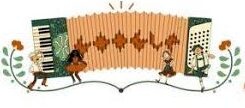
On Thursday, Google Doodle commemorated the ‘accordion,’ a German musical instrument patented on this day in 1829, affectionately calling it a folk musician’s “main squeeze.” This versatile free-reed instrument with bellows has left an indelible mark on diverse music genres, ranging from pop and jazz to folk and classical.
As emphasized by Google Doodle, the term “accordion” originates from the German word “akkord” (chord). Alongside instruments like the concertina, bandoneon, and harmonium, the accordion emerged in the early 1800s among free-reed instruments featuring bellows.
The Doodle showcased a music theme where the “Google” logo was ingeniously integrated within the bellows of an accordion. The illustration depicted artists dressed in traditional German attire dancing to the melodious tunes played by the accordion.
In the late 19th century, German manufacturers significantly increased accordion production to meet the growing demand among European folk musicians. Initially, accordions were designed with buttons on a single side, where each button produced a complete chord. Depending on whether the bellows were pushed or pulled, these buttons could generate two different chords.
The global spread of European emigrants further popularized the accordion in diverse music styles around the world. Modern accordions can now be equipped with either buttons or a piano keyboard, and some models even incorporate both.
In contemporary times, some accordions integrate electronic components, enabling them to connect to amplifiers or generate synthesized tones.
Today, the accordion holds sway in a variety of genres including folk music, Latino polka, tango, and Cajun music. It’s particularly synonymous with Oktoberfest, a celebratory event renowned for its carnival ambiance, music, and iconic attire such as Dirndls and lederhosen.





